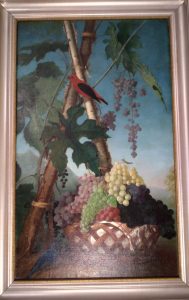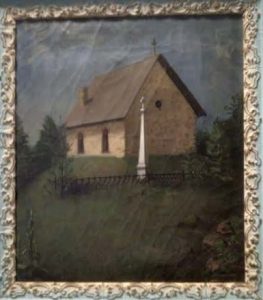
Primarily known as a portrait painter in Milwaukee, Bernard Isaac Durward (1817-1902), was a native of Montrose, Scotland In addition to portraits, he also painted numerous religious subjects and still life paintings as well as creating several altar pieces for churches in the Milwaukee area. He also became known for his poetry. His volume of poetry, Cristofero Colombo (1889), was celebrated at the 1893 World’s Fair at Chicago as the “best original and extended epic yet written in this land.” (6) Additionally, he was a collector, having acquired a number of works for his gallery at Durward’s Glen from other Wisconsin artists of the time. Bernard’s son, Charles Durward (1844-1875), was also a painter, especially of religious scenes and sites in Europe.

The youngest of five children, Bernard’s father died when he was an infant and the family struggled financially. He had to work as a youngster, becoming a shepherd boy in the Grampian Hills at age 8 and apprenticed to become a shoemaker at 12 to James Horne who also provided instruction in reading and writing. Bernard’s introduction to art was through the imitation of the works of others, which he sought to replicate in watercolor and crayon. He later became adept with the use of oils. He married Margaret Hillyard in 1842 and briefly settled in England where their sons Bernard Jr. and Charles were born in 1844. In 1845 the young artist embarked with his wife and two children on a one month ocean voyage across the Atlantic and made his way by the Erie Canal and the Great Lakes to Milwaukee, Wisconsin, where Bernard’s uncle Martin lived. After a short lived attempt to homestead in Dodge County near Neosho, the Durwards moved back to Milwaukee where they eventually had an original home built called the ‘Octagon House’ on the land now called Gordon Park. Bernard became a successful portrait painter, with his subjects being many of Milwaukee’s elite, including Solomon Juneau and Bishop John Henni, the first Bishop of Milwaukee, who would influence Bernard to convert to Catholicism in 1853.

Bernard also had literary success as fifty of his short poems were printed in the Milwaukee Sentinel, the Crayon of New York, and the Leader of St. Louis. His poem, May (1855), won special praise while his most famous was St. Mary’s of the Pines, written during the Civil War. When St. Francis Seminary in Milwaukee opened in 1856 he joined the faculty teaching English and elocution. He also taught painting to the School Sister of Notre Dame in Milwaukee. In 1862, the Durward family moved for a final time to the Baraboo Hills at a place they called ‘Durward’s Glen.’ Bernard sought the contemplative solitude of nature to inspire his religious art though as he aged he focused more on writing and poetry. He continued to support his family through painting commissions and teaching at the seminary until his death. Besides Charles, his other children included Bernard Jr. (1843-1855); two who became priests, John (1847-1918) and James (1851-1933); musician and writer, Wilfred (1857-1927); farmer, Andrew (1861-1926); and two daughters, Emma (1850-1852), and Mary Thecla (1863-1946), the only one born at the Glen.

Charles Durward was baptized a Roman Catholic in 1853 and attended St. Francis School. He traveled to Europe, where he painted Chester Cathedral from St. John’s Priory Window, Immaculate Conception of Our Lady of Lourdes, St. Charles Borromeo, the Madonna of the Sleep, and the Stable of Bethlehem. He later purchased six acres from his father and built a small home (later a guest house of the Order of St. Camillus) where he painted Madonna del Colombo and Stations in 1874, shortly before his untimely death due to eating the poisonous water hemlock plant. He was buried at St. Mary of the Pines. This artistic family was summed up “as eccentric, a reputation which was not diminished when the son, Charles, also began to paint and erected in the glen a studio and gallery for the quiet pursuit of religious art. These unusual proceedings, coupled with the ritualistic devotion of the family members toward one another (referring to each other as ‘the Artistic Brother,’ ‘the Poet Father,’ etc), were not calculated to bring art very close to the interests of the farmer natives.”(7) The bulk of the Durward Collection now resides in the Museum section of Special Collections at The Catholic University of America in Washington D.C. Father John Durward had visited Catholic in 1909, striking up a friendship with Rector, Thomas J. Shahan. Subsequently, the initial donation of three paintings was made in 1919 by the John Durward Estate, and two of these, Madonna of the Dove and Madonna of the Sleep, are prominently displayed on campus. A further, substantial donation of 41 paintings was made in 2007 by the Order of St. Camillus. It is also of note that four of the paintings were returned to Catholic University in 2021 after being on long term loan to the Museum of Wisconsin Art.

(1) NMC 19, A framed oil painting, 30 by 38 inches.
(2) Mary Grace Terry. The Story of Durward’s Glen. Order of St. Camillus, 1958, p. 7.
(3) A framed oil painting by Bernard I. Durward, 24 x 35.5 inches. NMC 1163
(4) Terry, p. 31.
(5) A framed oil painting by Bernard I. Durward, 16.25 x 18.75 inches. NMC 1154
(6) Porter Butts. Art in Wisconsin. (1936), p. 78.
(7) Ibid, p. 78.

You are so interesting! I do not think I’ve truly read anything like that before. Good Sharing Thanks.
Pretty! This was a really wonderful post. Thank you for providing these episodes.